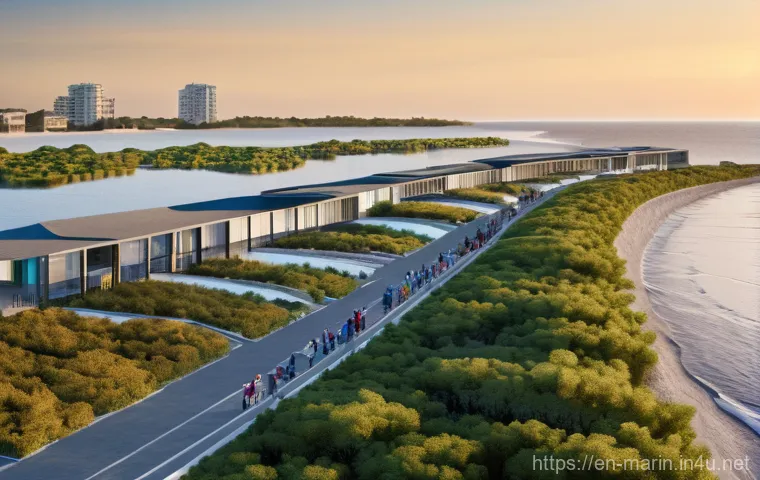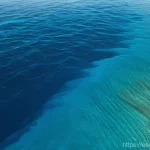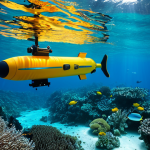Hey there, ocean lovers and curious minds! If you’re anything like me, you probably look at our planet’s magnificent oceans and feel a deep sense of wonder.
They’re not just vast bodies of water; they’re the very heart of our global climate system, quietly working to regulate everything from our weather patterns to the air we breathe.
But lately, I’ve been diving deep into the science, and what I’ve learned about how climate change is affecting our oceans truly hits differently. From record-shattering ocean temperatures and terrifying marine heatwaves that devastate coral reefs, to the relentless rise in sea levels and increasing acidification, our blue planet is under immense pressure.
It’s a huge challenge, but thankfully, brilliant minds are hard at work using something incredible: ocean climate change modeling. These aren’t just fancy computer programs; they’re our best shot at understanding the ocean’s intricate dance with our atmosphere and predicting what the future holds.
I’ve seen firsthand how these models, constantly evolving with cutting-edge innovations like AI and deep learning techniques, are becoming incredibly sophisticated.
They’re helping us untangle complex interactions, from shifting ocean currents like the Atlantic Meridional Overturning Circulation to the nuanced effects on marine ecosystems.
The goal is to paint the clearest picture possible of potential future scenarios, allowing us to make smarter decisions to protect coastal communities and precious biodiversity.
It’s about more than just numbers; it’s about anticipating challenges, finding solutions, and building a resilient future for our oceans and ourselves.
Trust me, the insights are eye-opening, and you’re going to want to know what’s coming next. Let’s truly understand what’s at stake and how these models are shaping our future.
Unveiling the Ocean’s Hidden Alarms

Okay, so let’s really get into the heart of it, shall we? You know how sometimes you just *feel* like something’s off, even if you can’t quite put your finger on it? Well, our oceans have been sending out those vibes for a while now, and thankfully, brilliant scientists have been developing sophisticated tools to translate those subtle warnings into actionable insights. It’s not just about rising temperatures anymore; it’s about a complex web of changes that impacts everything from the tiniest plankton to the biggest whales, and ultimately, us. I’ve spent countless hours digging into the research, and what truly struck me is how these models aren’t just predicting a future that *might* happen, but a future that, in many ways, is already unfolding. We’re talking about acidification changing the very chemistry of the water, making it harder for shelled creatures to survive, and marine heatwaves becoming more frequent and intense, literally cooking coral reefs alive. It’s a gut punch, to be honest, seeing the data, but it also lights a fire under you to understand and act. These models are our early warning system, helping us piece together the global puzzle of ocean health.
The Silent Threat of Ocean Acidification
One of the aspects that truly keeps me up at night is ocean acidification. It’s often overshadowed by rising temperatures, but trust me, it’s just as insidious. When I first learned about how the ocean absorbs excess carbon dioxide from the atmosphere, turning it more acidic, I honestly hadn’t grasped the scale of the problem. But then you see the models. They show how these subtle shifts in pH can have devastating consequences for marine life, especially those organisms that rely on calcium carbonate to build their shells and skeletons, like oysters, mussels, and coral polyps. Imagine trying to build a house when your bricks are slowly dissolving – that’s essentially what these creatures are facing. It’s not just about one species; it’s about entire food webs collapsing from the bottom up. The models project frightening scenarios for shellfish industries and coral reef ecosystems, which are vital nurseries for countless fish species and protectors of our coastlines. It’s a stark reminder that even seemingly small changes can have colossal ripple effects across the entire marine environment.
Decoding Marine Heatwaves and Their Intensity
Another area where these models are absolutely crucial is understanding marine heatwaves. You might think, “Oh, it’s just a bit warmer,” but believe me, it’s so much more than that. I remember reading about the ‘Blob’ in the Pacific a few years back, and how it completely upended marine ecosystems, from salmon populations crashing to sea lion pups starving. These heatwaves are essentially oceanic extreme weather events, and models are helping us predict where and when they’re likely to occur, and how intense they’ll be. It’s like having a weather forecast, but for the ocean’s temperature. They’re showing us how these pockets of unusually warm water are becoming more frequent, lasting longer, and covering larger areas, putting incredible stress on marine life that simply can’t adapt fast enough. From devastating coral bleaching events in the Great Barrier Reef to massive die-offs of kelp forests, the impacts are profound. These insights from the models are absolutely vital for conservation efforts, allowing us to identify vulnerable areas and potentially implement emergency measures to protect marine biodiversity before it’s too late. It gives me a glimmer of hope that armed with this knowledge, we can be proactive rather than just reactive.
Building a Digital Twin of Our Blue Planet
It’s truly mind-boggling to think about, but what scientists are essentially doing is constructing a “digital twin” of our vast, complex oceans. Imagine taking all the physics, chemistry, and biology that govern the seas and translating it into lines of code – it’s an ambitious undertaking, to say the least! When I first delved into how these models are built, I was picturing giant supercomputers humming away, and while that’s part of it, it’s also about the incredible human ingenuity behind the algorithms. They take colossal amounts of data – from satellite observations tracking ocean currents and sea surface temperatures, to autonomous underwater vehicles measuring salinity and oxygen levels at various depths, and even historical records spanning decades. All of this information is fed into these intricate mathematical frameworks that simulate how the ocean behaves. It’s not just a snapshot; it’s a dynamic, evolving representation that allows researchers to essentially fast-forward or rewind time, exploring different scenarios. I honestly feel like we’re living in a sci-fi movie when I think about the precision and scale of these simulations. It’s our best shot at understanding the complex interplay between the atmosphere, ice, land, and of course, the ocean, and seeing how changes in one system cascade through the others.
From Satellites to Submersibles: The Data Foundation
You can’t build an accurate model without accurate data, right? And when it comes to the ocean, getting that data is a monumental task. I’ve always been fascinated by the sheer variety of tools scientists use to collect information from our planet’s most inaccessible regions. We’re talking about high-tech satellites orbiting hundreds of miles above, peering down to measure sea level changes with incredible accuracy and monitor ocean color, which tells us about phytoplankton concentrations. Then, closer to home, there are thousands of Argo floats drifting across the global ocean, profiling temperature and salinity down to depths of 2,000 meters every ten days – talk about dedication! And let’s not forget the gliders and autonomous underwater vehicles (AUVs) that can collect data in places too dangerous or remote for humans, like under ice sheets. When you combine all these diverse data streams, it’s like getting millions of tiny puzzle pieces that, when assembled by these models, start to reveal the grand picture of our ocean’s health. It truly makes you appreciate the incredible effort and coordination involved in global ocean observation. I mean, who would have thought a little robot could tell us so much about the deep sea?
The Art and Science of Model Calibration
Now, here’s where it gets really interesting – and, dare I say, a bit like detective work! Building a model is one thing, but making sure it accurately reflects reality is another challenge entirely. This is where model calibration and validation come into play. It’s not a one-and-done process; it’s a continuous cycle of refinement. Scientists compare the model’s outputs with real-world observations – those satellite images, buoy readings, and ship data – to see how well they align. If there’s a discrepancy, they tweak the model’s parameters, adjust the equations, or even incorporate new physical processes until the simulations closely match what we actually observe in the ocean. It’s an iterative dance of trial and error, constantly pushing for greater accuracy. I remember hearing a researcher explain it as “tuning an orchestra,” where every instrument (or data point/equation) needs to be perfectly in sync. This rigorous process is what builds trust in these models, allowing us to have confidence in their projections. Without meticulous calibration, these digital oceans would just be pretty pictures; with it, they become powerful tools for foresight and decision-making.
The Superpowers Behind Our Climate Crystal Ball
If you’re anything like me, you’ve probably wondered what kind of magic makes these complex ocean climate models actually *work*. Well, it’s not magic, but it feels pretty close sometimes, especially with the leaps and bounds in technology we’re seeing. We’re talking about massive supercomputers, the kind that can perform quadrillions of calculations per second, working tirelessly to process the mind-boggling amount of data and run the intricate simulations. But it’s more than just raw computing power; it’s also about the sophisticated mathematical frameworks and the brilliant minds behind them. They’re using cutting-edge computational fluid dynamics, thermodynamic equations, and even biogeochemical cycles to simulate everything from ocean currents and heat transport to the growth of phytoplankton and the cycling of carbon. And get this – the integration of Artificial Intelligence (AI) and deep learning techniques is truly revolutionizing the field. I’ve been following how these advanced algorithms are being used to identify patterns in vast datasets that human eyes might miss, or to improve the efficiency and accuracy of model components. It’s like giving our climate crystal ball a major upgrade, making it sharper, faster, and more insightful than ever before. It truly feels like we’re standing at the precipice of a new era in climate science, all thanks to these technological ‘superpowers.’
AI and Deep Learning: The New Frontier
Honestly, when I first heard about AI being used in ocean modeling, my ears perked right up! We all know AI is changing so many aspects of our lives, and now it’s helping us understand our oceans better. It’s not about robots taking over, but rather intelligent algorithms supercharging the scientific process. I’ve learned that deep learning, a subset of AI, is particularly good at spotting subtle correlations and complex non-linear relationships within enormous datasets – the kind of relationships that are notoriously difficult for traditional models to capture. For instance, AI can help in parameterizing sub-grid scale processes, which are phenomena too small to be explicitly resolved by the model’s grid but crucial for overall accuracy, like turbulent mixing. It can also enhance predictive capabilities by learning from past observations and even accelerate simulations by finding more efficient ways to solve complex equations. This means we can run more scenarios, explore uncertainties with greater nuance, and get quicker insights into future ocean conditions. It’s truly exciting to see how these intelligent systems are not replacing human scientists, but rather empowering them to ask bigger questions and find more comprehensive answers. It makes me feel optimistic about our ability to tackle this massive challenge.
High-Performance Computing: The Engine Room
Let’s be real, you can have the most brilliant algorithms in the world, but if you don’t have the horsepower to run them, they’re just lines of code. This is where high-performance computing (HPC) comes into its own as the absolute engine room of ocean climate modeling. When I think about the sheer computational demands of simulating an entire global ocean, with all its intricate dynamics and interactions, my head spins a little! These models slice the ocean into millions of tiny grid cells, and for each cell, they’re calculating temperature, salinity, currents, pressure, and countless other variables at multiple depths, and then repeating those calculations for every single simulated time step, often over hundreds of years. This requires supercomputers capable of performing trillions upon quadrillions of operations per second, often utilizing thousands of interconnected processors working in parallel. Without these technological marvels, running such detailed, high-resolution simulations would simply be impossible, or take lifetimes. It’s a constant race to build faster, more efficient machines to keep up with the ever-increasing complexity and resolution of the models. It just shows you that addressing climate change isn’t just about environmental science; it’s a full-on technological frontier that pushes the boundaries of engineering and computer science.
From Bytes to Breakthroughs: How Models Guide Us
So, we’ve talked about how these incredible ocean models are built and the tech that powers them. But what’s the *real* impact? How do these intricate simulations, these endless bytes of data, actually translate into meaningful breakthroughs that help us protect our blue planet? This is where the rubber meets the road, and honestly, it’s the most inspiring part. These models aren’t just academic exercises; they are vital tools for policymakers, coastal planners, conservationists, and even industries like fishing and shipping. They provide the foresight we desperately need in a rapidly changing world. Imagine being able to anticipate which coastal communities are most at risk from sea level rise and extreme storms, allowing us to proactively build seawalls or develop relocation strategies. Or understanding how shifting ocean currents might impact fish migration routes, helping fisheries adapt and ensure sustainable practices. I’ve seen firsthand how these projections, even with their inherent uncertainties, empower us to make smarter, more informed decisions. It’s about moving beyond simply reacting to climate change and instead, strategically planning for a more resilient future. The information they provide is truly invaluable, transforming scientific understanding into tangible action and giving me a genuine sense of hope for our ability to adapt.
Informing Coastal Resilience Strategies
One of the most immediate and tangible ways these models are making a difference is in informing coastal resilience. For anyone who lives near the ocean, or whose livelihood depends on it, the threat of rising sea levels and more intense storm surges is very real. I’ve personally watched news reports of devastating coastal flooding, and it always makes me wonder what could have been done to prepare. That’s where these models come in. They can project localized sea level rise scenarios, factoring in everything from thermal expansion of water to melting glaciers and ice sheets. More importantly, they can simulate the impact of extreme weather events, showing us which areas are most vulnerable to inundation and erosion. This isn’t just abstract data; it translates directly into actionable plans: where to fortify existing infrastructure, where to restore natural coastal defenses like mangroves and salt marshes, or even where to implement managed retreat for communities facing insurmountable risks. It’s about giving coastal towns and cities the knowledge they need to build stronger, safer, and more adaptable futures. This proactive approach, guided by model insights, feels like a real game-changer in protecting our homes and economies.
Guiding Marine Conservation Efforts

For someone who cares deeply about marine life, the role of ocean models in conservation is incredibly compelling. Our oceans are home to an astounding diversity of species, many of which are already under immense pressure. These models act like a spotlight, helping us pinpoint where and how climate change impacts are hitting marine ecosystems the hardest. For example, they can project the future distribution of vital habitats like coral reefs or kelp forests under different warming scenarios, allowing conservationists to identify critical refugia – areas that might be more resilient to change. They also help predict shifts in species distribution, showing how fish stocks might move poleward in search of cooler waters, which has huge implications for marine protected area design and fisheries management. I’ve followed stories of how model projections have influenced decisions on where to establish new marine sanctuaries or how to adjust fishing quotas to account for climate-driven changes. It’s about making conservation efforts more strategic, more effective, and ultimately, giving our incredible ocean creatures a fighting chance against the monumental challenges they face. Knowing this makes me feel like there’s a real plan taking shape.
Navigating the Storm: Challenges and Triumphs
Let’s be honest, building a digital replica of an entire ocean and predicting its future isn’t a walk in the park. It’s filled with monumental challenges, and sometimes, when you look at the complexity, it can feel a bit daunting. But that’s precisely why the triumphs in this field are so incredibly inspiring! One of the biggest hurdles is the sheer scale and complexity of the ocean itself. It’s enormous, deep, and constantly moving, with interactions happening at every conceivable scale, from tiny eddies to massive currents like the Gulf Stream. Then there’s the ‘garbage in, garbage out’ problem – the models are only as good as the data you feed them, and collecting comprehensive, consistent data from every corner of the ocean is a logistical nightmare. And let’s not forget the inherent uncertainties in predicting future emissions and how various Earth systems will respond. Despite all these obstacles, the progress made over the past few decades is nothing short of revolutionary. We’ve moved from relatively simple models to incredibly sophisticated Earth System Models that couple the ocean, atmosphere, land, and ice. This journey is a testament to human perseverance, ingenuity, and a deep collective commitment to understanding our planet. Every time a model accurately predicts an extreme event or helps inform a new policy, it feels like a small, but significant, victory in the larger fight against climate change.
The Art of Handling Uncertainty
When we talk about future predictions, whether it’s the weather next week or ocean conditions decades from now, there’s always an element of uncertainty. And with something as complex as ocean climate modeling, this becomes a critical factor. I’ve come to understand that uncertainty isn’t a weakness; it’s an inherent part of the science, and recognizing it is actually a strength. Scientists aren’t just giving us one single prediction; they’re often providing a range of possible outcomes, sometimes called ‘ensembles’ of model runs, reflecting different scenarios for future greenhouse gas emissions and variations in initial conditions. It’s like saying, “If we continue on this path, here’s the most likely scenario, but also consider these less likely, but still possible, extremes.” The beauty is in how they quantify this uncertainty, giving decision-makers a clearer picture of the risks involved. This allows for robust planning that can account for a spectrum of possibilities, rather than relying on a single, potentially misleading forecast. For me, it makes the models more trustworthy, because they’re being transparent about the limitations while still providing invaluable guidance. It’s a pragmatic approach to a truly complex problem, and one I deeply appreciate.
Model Resolution and Computational Demands
Imagine trying to draw a detailed map of an entire country. The more detail you want, the finer your lines, the more paper you need, and the longer it takes, right? It’s similar with ocean models and their resolution. Higher resolution means dividing the ocean into smaller grid cells, which allows the model to capture finer-scale processes like ocean eddies – those swirling whirlpools that are crucial for transporting heat and nutrients. But here’s the kicker: doubling the resolution in a 3D model doesn’t just double the computational power needed; it can increase it by a factor of eight or more! I’ve learned that striking the right balance between resolution and computational feasibility is a constant challenge for model developers. While we’d ideally want kilometer-scale resolution globally, the current supercomputers aren’t quite there yet for long-term climate simulations. So, scientists often use a hierarchy of models, from global lower-resolution models for long-term trends to regional high-resolution models for specific areas of interest. It’s a continuous push against the boundaries of technology, always striving for more detail and accuracy without making the simulations impossibly slow. This constant innovation is what keeps the field so dynamic and, frankly, exciting!
Beyond the Forecast: Securing a Brighter Ocean Future
So, after all this talk about models, data, and predictions, what’s the ultimate goal? It’s not just to know what’s coming, but to *do something* about it. For me, the true power of ocean climate change modeling lies in its ability to empower us, to shift us from feeling helpless to becoming active participants in shaping a better future for our oceans. These models are giving us the critical information we need to not only mitigate the worst impacts of climate change by guiding emissions reductions but also to adapt to the changes that are already inevitable. They are fostering a deeper understanding of the intricate connections within Earth’s climate system, allowing us to see how our actions on land reverberate through the vastness of the ocean. It’s about leveraging cutting-edge science and technology to build a more resilient planet, protecting vulnerable ecosystems, safeguarding coastal communities, and ensuring the continued health of the marine environment that sustains us all. I truly believe that by listening to what these digital oceans are telling us, and by acting on that knowledge, we can navigate these turbulent waters and chart a course towards a brighter, bluer future. It’s a monumental task, but with these tools, and a collective will, I feel genuinely optimistic.
Translating Science into Action and Policy
One of the things that consistently impresses me about the climate science community is their dedication to not just *doing* the science, but ensuring it actually *matters*. And a huge part of that is translating these complex model outputs into understandable, actionable insights for policymakers. It’s not an easy job, because policy decisions involve so many factors beyond just scientific data – economic, social, political. But these models provide the crucial scientific foundation. I’ve followed instances where model projections on future sea level rise have directly influenced government decisions on infrastructure investments, or where predictions of marine heatwaves have spurred emergency conservation measures. The clear, evidence-based scenarios presented by these models are incredibly powerful tools in policy debates, helping to cut through noise and focus on what the science unequivocally tells us. It’s about bridging the gap between the scientific lab and the legislative chamber, ensuring that decisions impacting our oceans are rooted in the best available knowledge. This direct line from sophisticated modeling to real-world policy is where the greatest impact is made, and it’s a process I deeply respect.
Fostering Global Collaboration and Innovation
You know, for all the talk about supercomputers and advanced algorithms, at its heart, ocean climate change modeling is a deeply human endeavor. And what’s truly inspiring is the level of global collaboration it fosters. No single institution or country can tackle the complexity of modeling the entire global ocean alone. I’ve learned about massive international projects where scientists from different continents share data, code, and expertise, all working towards a common goal. This spirit of collaboration is absolutely essential, allowing for the pooling of resources, the sharing of best practices, and the collective advancement of the science. It also sparks incredible innovation, as researchers from diverse backgrounds bring fresh perspectives to solving entrenched problems. From standardized protocols for data collection to open-source model development, the global scientific community is constantly pushing the boundaries together. This shared sense of purpose, united by a desire to understand and protect our oceans, gives me immense hope. It’s a powerful reminder that when we come together, armed with knowledge and a common goal, there’s truly no challenge we can’t at least make significant headway against. It’s an example of humanity at its best, in my opinion.
| Ocean Climate Challenge | Key Model Insight/Application | Real-World Impact Example |
|---|---|---|
| Sea Level Rise | Projecting localized sea level rise under various emissions scenarios. | Informing coastal protection projects in New York City or adapting infrastructure in low-lying island nations. |
| Ocean Acidification | Simulating changes in ocean pH and carbonate saturation states. | Guiding oyster farm management strategies to mitigate impacts on shellfish or identifying resilient coral species. |
| Marine Heatwaves | Predicting the frequency, intensity, and duration of marine heatwaves. | Implementing emergency conservation measures for vulnerable marine ecosystems like kelp forests or coral reefs. |
| Shifting Fish Stocks | Forecasting changes in marine species distribution due to warming waters. | Adjusting fishing quotas and marine protected area boundaries to ensure sustainable fisheries. |
| Changes in Ocean Currents | Modeling the strength and stability of major ocean currents (e.g., AMOC). | Assessing potential impacts on regional weather patterns, heat distribution, and nutrient cycling. |
글을마치며
Whew! What a deep dive, right? It’s truly incredible to think about the sheer brainpower and technological marvels that go into understanding our oceans and, ultimately, predicting their future. After spending so much time immersed in this topic, I’m left with a mix of awe and a renewed sense of urgency. These models aren’t just abstract scientific tools; they are our clearest window into the profound changes our blue planet is undergoing. They offer us the data and the foresight we desperately need to make informed decisions, foster resilience, and actively shape a healthier marine environment for generations to come. It truly feels like we have a roadmap, and now it’s up to us to follow it.
알아두면 쓸모 있는 정보
1. Did you know that you can actually explore some of these ocean model visualizations yourself? Many scientific institutions, like NOAA or university research centers, often share publicly accessible data and interactive maps. It’s a fantastic way to grasp the scale of oceanographic changes firsthand and truly appreciate the complexity scientists are tackling.
2. Beyond large-scale climate models, localized oceanographic forecasting models are crucial for everyday activities. Think about surf reports, fishing conditions, or even safe shipping routes – these are all influenced by short-term ocean models that predict currents, wave heights, and even marine weather.
3. Your personal carbon footprint, no matter how small it feels, directly impacts ocean health. Reducing energy consumption, choosing sustainable transportation, and supporting renewable energy initiatives all contribute to less CO2 in the atmosphere, which means less absorption by the ocean and a slower rate of acidification.
4. Supporting organizations that fund oceanographic research and climate modeling is a powerful way to make a difference. These groups are often on the front lines, providing the resources needed for scientists to continue their vital work, develop better models, and translate findings into real-world action.
5. Ever considered citizen science? There are numerous initiatives, from reporting marine wildlife sightings to participating in beach cleanups, that directly contribute to the real-world data collection efforts used to validate and improve ocean models. Every piece of information helps paint a clearer picture!
중요 사항 정리
So, let’s wrap this up with the absolute core takeaways that I truly want you to remember. Firstly, ocean climate models are our indispensable early warning system, meticulously designed to translate the complex ‘signals’ our oceans are sending into actionable insights about acidification, heatwaves, and more. Secondly, these aren’t just theoretical constructs; they are digital twins of our blue planet, built on a foundation of massive datasets from satellites to submersibles, and powered by the awe-inspiring capabilities of high-performance computing and even AI. Finally, and most importantly, these scientific breakthroughs aren’t just for academic circles. They are potent tools guiding us towards concrete actions, from fortifying coastal communities and protecting marine ecosystems to informing global policy. It’s about empowering us to proactively secure a brighter, more resilient future for our incredible oceans.
Frequently Asked Questions (FAQ) 📖
Hey there, ocean lovers and curious minds! If you’re anything like me, you probably look at our planet’s magnificent oceans and feel a deep sense of wonder.
They’re not just vast bodies of water; they’re the very heart of our global climate system, quietly working to regulate everything from our weather patterns to the air we breathe.
But lately, I’ve been diving deep into the science, and what I’ve learned about how climate change is affecting our oceans truly hits differently. From record-shattering ocean temperatures and terrifying marine heatwaves that devastate coral reefs, to the relentless rise in sea levels and increasing acidification, our blue planet is under immense pressure.
It’s a huge challenge, but thankfully, brilliant minds are hard at work using something incredible: ocean climate change modeling. These aren’t just fancy computer programs; they’re our best shot at understanding the ocean’s intricate dance with our atmosphere and predicting what the future holds.
I’ve seen firsthand how these models, constantly evolving with cutting-edge innovations like AI and deep learning techniques, are becoming incredibly sophisticated.
They’re helping us untangle complex interactions, from shifting ocean currents like the Atlantic Meridional Overturning Circulation to the nuanced effects on marine ecosystems.
The goal is to paint the clearest picture possible of potential future scenarios, allowing us to make smarter decisions to protect coastal communities and precious biodiversity.
It’s about more than just numbers; it’s about anticipating challenges, finding solutions, and building a resilient future for our oceans and ourselves.
Trust me, the insights are eye-opening, and you’re going to want to know what’s coming next. Let’s truly understand what’s at stake and how these models are shaping our future.
A1: You know, when I first heard “ocean climate change models,” I pictured some super complicated, top-secret government project. And while they *are* incredibly complex, they’re essentially sophisticated computer programs that simulate how the ocean behaves.
Think of them as digital twins of our oceans, trying to mimic every wave, every current, every chemical reaction, and every temperature fluctuation. They’re built on fundamental laws of physics, chemistry, and biology, using massive amounts of data collected from satellites, buoys, and even research ships.
Scientists feed these models everything from ocean temperatures and salinity levels to atmospheric pressure and wind patterns. Then, supercomputers crunch all that data, running simulations that can project how the ocean might change decades or even centuries into the future under different climate scenarios.
It’s like building a virtual crystal ball, but one based on hardcore science and incredible computational power. I’ve personally been fascinated by how they can even factor in things like how marine life responds to warming waters!
A2: Honestly, these models are nothing short of critical. Without them, we’d be flying blind when it comes to climate change’s impact on our oceans. I’ve come to realize they’re our guiding light, helping us understand potential future scenarios so we can make informed decisions today.
They paint a pretty vivid, albeit sometimes sobering, picture of what’s to come. For instance, we’re seeing clearer predictions about sea level rise – not just globally, but localized projections that help coastal communities plan for storm surges and erosion.
They’re also forecasting an increase in marine heatwaves, which I’ve found incredibly worrying, as these events are devastating coral reefs and vital ecosystems.
Another big one is ocean acidification; the models show us how increasing CO2 absorption is turning our oceans more acidic, threatening shellfish and other marine life.
And let’s not forget the shifting ocean currents, like the Atlantic Meridional Overturning Circulation (AMOC), which could dramatically alter weather patterns across continents.
It’s not just doom and gloom though; these insights also empower us to develop adaptation strategies and focus our conservation efforts where they’ll have the biggest impact, which, for me, brings a lot of hope.
A3: Oh, this is where it gets really exciting! I’ve been watching the integration of AI and deep learning into ocean modeling with genuine awe. It’s like giving these already powerful models a serious brain upgrade.
Traditionally, these models rely on incredibly complex equations, and sometimes, those equations can struggle with the sheer scale and nuance of ocean processes.
That’s where AI steps in. I’ve learned that AI can identify intricate patterns in vast datasets that human eyes or traditional algorithms might miss. For example, deep learning algorithms can be trained on past ocean data to predict future temperature anomalies with greater accuracy and speed.
They’re especially good at refining the smaller-scale processes that older models sometimes had to simplify, like turbulence or nutrient cycling. This means more precise projections, especially for extreme events like marine heatwaves or sudden changes in current.
It’s like they’re able to learn from the ocean itself, helping us anticipate challenges and find solutions for a more resilient future. It’s truly a game-changer, and it makes me feel like we have a much better shot at protecting our magnificent blue planet.





